Research Article, J Immunol Tech Infect Dis Vol: 12 Issue: 2
Seroprevalence of SARS-CoV-2(COVID-19) Antibody among Blood Donors in a Tertiary Care Centre in South India
Sherin John1*, Aboobacker Mohamed Rafi1, Ramesh Bhaskaran1 and Chithra Valsan2
1Department of Immunohematology and Blood Transfusion, Jubilee Mission Medical College and Research Institute, Thrissur, India
2Department of Microbiology, Jubilee Mission Medical College and Research Institute, Thrissur, India
*Corresponding Author: Sherin John,
Department of Immunohematology and Blood Transfusion, Jubilee Mission Medical College and Research Institute, Thrissur, India
E-mail: sherinsjohn2020@gmail.com
Received date: 06 June, 2023, Manuscript No. JIDIT-23-101686;
Editor assigned date: 08 June, 2023, PreQC No. JIDIT-23-101686 (PQ);
Reviewed date: 23 June, 2023, QC No. JIDIT-23-101686;
Revised date: 30 June, 2023, Manuscript No. JIDIT-23-101686 (R);
Published date: 07 July, 2023, DOI: 10.4172/2329-9541.1000340.
Citation: John S, Rafi AM, Bhaskaran R, Valsan C (2023) Seroprevalence of SARS-CoV-2(COVID-19) Antibody among Blood Donors in a Tertiary Care Centre in South India. J Immunol Tech Infect Dis 12:2.
Abstract
Introduction: The novel Severe Acute Respiratory Syndrome Virus 2 (SARS-CoV-2), which is responsible Coronavirus disease (COVID-19), spread worldwide from China, causing a pandemic from late December 2019. Due to the high proportion of asymptomatic or mild infections (Approximately 80%), data restricted to laboratory-confirmed cases do not capture the true extent of the spread or burden of the virus, or its infectionfatality ratio. Therefore, serological detection of specific antibodies against SARS-CoV-2 can better estimate the true number of infections. The current study aims to estimate the seroprevalence of SARS-CoV-2 antibodies among the whole blood donors without any prior COVID-19 history or symptoms.
Objective: To determine seroprevalence of SARS-CoV-2 (COVID-19) antibody (IgG and IgM) among asymptomatic healthy blood donors.
Methods: This was a cross sectional study conducted between March and July, 2021 among 300 blood donors without any prior COVID-19 history or symptoms who came to a tertiary care, multispecialty hospital in south India. Any donor who had recently travelled abroad or donors who had received COVID-19 vaccine are excluded from the study. 3 ml venous blood was drawn in EDTA tube from participants and was tested by “Access SARS CoV-2 IgG assay” and “Access SARS CoV-2 IgM assay” by UniCel DxI 800 Immunoassay analyzer (Beckman coulter). The Access SARS CoV-2 IgG assay and the Access SARS Cov-2 IgM assay detect antibodies to the Receptor Binding Domain (RBD) of the Spike Protein. Result was reported as Reactive if Signal/Cut-off (S/CO)>1.0 and non- Reactive if S/CO <1.
Data was collected and entered into excel sheets and was analyzed by using the software SPSS version 25.
Results: A total of 300 healthy blood donors were included. The study reported seroprevalence of 15.3% for IgG and 4.3% for IgM (95%CI) among asymptomatic whole blood donors. No significant difference was observed across age groups, diet, BMI, ABO/Rh blood type or Ayurveda/homeo immune medicine intake with respect to IgG and IgM reactivity.
Conclusion: 15% of blood donors were seroconverted for COVID-19 during second wave. This is a reflection of widespread seroprevalence in the adult population. Real-time seroprevalence studies will help to know the herd immunity among the blood donors which will assist in knowing the COVID-19 transmission dynamics and distribution of immunity levels at a particular point in time.
Keywords: COVID-19; Seroprevalence; Blood donors
Introduction
Severe Acute Respiratory Syndrome Virus 2 (SARS-CoV-2), which is responsible for Coronavirus Disease (COVID-19), has spread worldwide from China since late December 2019. The disease was declared as a Public Health Emergency of International Concern and later as a global pandemic by the World Health Organization. Due to the high proportion of asymptomatic or mild infections (Approximately 80%), data restricted to laboratory-confirmed cases do not capture the true extent of the spread or burden of the virus, or its infection-fatality ratio. Therefore, serological detection of specific antibodies against SARS-CoV-2 can better estimate the true number of infections [1].
Evaluating the prevalence of COVID-19 infection among healthy blood donors is important. WHO has currently provided no recommendations about screening the donors for SARS-CoV-2 by RTPCR or immunoassays, however, it recommends temporary deferral for 28 days if any symptoms (cough, fever, flu) are present, or if they are exposed to a confirmed COVID-19 patient or have travelled to an epidemic area. WHO also recommends that the potential donors also have to inform the blood bank if they develop symptoms within 28 days of donation. However, COVID-19 virus does not transmit through blood donations and is not a blood borne disease but identification of seroprevalence among the blood donors can give an estimate of circulation of the virus among healthy individuals, providing actual disease burden and real case fatality rate in a population [2].
Need and significance of the study
Seroprevalence of IgG antibodies against SARS-CoV-2 is an important tool to estimate the true extent of infection in a population. However, seroprevalence studies have been scarce in South East Asia including India, which, as of now, carries the second largest burden of confirmed cases in the world. Though we have similar studies among health professionals, there are not much data on seroprevalence among the healthy blood donors in our country.
Objective
To determine seroprevalence of SARS-CoV-2 (COVID-19) antibody (IgG and IgM) among asymptomatic healthy blood donors.
Methodology
Study design
Cross sectional study
Study setting and duration
The study was conducted over a period of eighteen months in the Department of Transfusion Medicine at Jubilee Mission Medical College and Research Institute, a tertiary care, multispecialty teaching hospital in Central Kerala.
Duration of the study
• 1 year and 6 months
• Sampling
• Systematic sampling
• Sample size
Based on the proportion of positive antibody cases observed in an earlier publication” Seroprevalence of SARS-CoV-2 antibodies among healthy blood donors in Karachi, Pakistan” with 95% confidence level and 20% relative allowable error, minimum sample size comes to 300.

Hypothesis
Null hypothesis: There are no detectable SARS CoV-2(COVID-19) antibodies among blood donors.
Alternate hypothesis: There are detectable SARS CoV-2(COVID-19) antibodies among blood donors.
Inclusion criteria:
• Age >18 years and <60 years, who fulfill the Donor criteria of D&C Act
• Donors with no symptoms of COVID-19 in the past 28 days
Exclusion criteria:
• Donors who had a history of COVID-19
• Any donor who had a close contact with other COVID-19 patients in the last 28 days
• Any donor who had travelled abroad or came back from abroad after January,2020
• Donors who have received COVID-19 vaccine
• Donors not willing to participate in the study
• All exclusions as per the donor deferral criteria of D&C Act and NACO guidelines for COVID-19 pandemic.
Sampling procedure: This is a cross sectional study to be conducted in the Department of Transfusion Medicine, Jubilee Mission Medical College and Research Institute, Thrissur. Blood samples are taken from 300 donors after systematic sampling.
Method of data collection
• This is a cross sectional study conducted in the Department of Transfusion Medicine, Jubilee Mission Medical College and Research Institute, Thrissur.
• Blood samples were taken from 300 blood donors after systematic sampling.
• Voluntary blood donors who came to Jubilee Mission Medical College, Thrissur who fulfilled the inclusion criteria were enrolled in the study.
• Written informed consent was obtained.
• Demographic data of donors including age, gender, address was noted.
• A Blood donor was required to answer the questionnaire provided.
• 3 ml venous blood was drawn in EDTA tube (lavender tube) from participants and was tested by “Access SARS CoV-2 IgG assay” and “Access SARS CoV-2 IgM assay” by UniCel DxI 800 Immunoassay analyzer (Beckman coulter).
• Blood collected from individuals who are positive for IgM will be discarded (Figure 1).
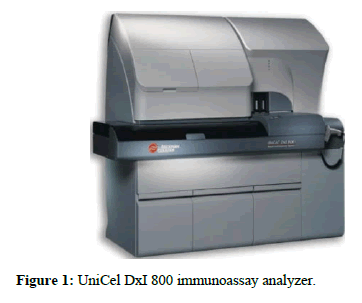
Figure 1: UniCel DxI 800 immunoassay analyzer.
Outcome measurement
Chemiluminescence Immunoassay (CLIA): IgG and IgM antibodies against SARS-CoV-2 are detected by two-step immunocapture immunoassay by UniCel DxI 800 Immunoassay analyzer (Beckman coulter). The Access SARS CoV-2 IgG assay and the Access SARS Cov-2 IgM assay detect antibodies to the Receptor Binding Domain (RBD) of the Spike Protein. Result was reported as Reactive if Signal/Cut-off (S/CO)>1.0 and Non-Reactive if S/CO<1
Pilot study: We conducted a pilot study among 20 asymptomatic healthy blood donors with no past history of COVID-19. In our study we observed IgG positivity in four individuals with a 20% seroprevalence.
Results
A hospital based cross sectional study was conducted over a period of five months in the Department of Immunohematology and Blood Transfusion, Jubilee Mission Medical College and Research Institute, Thrissur, Kerala in which 300 asymptomatic healthy blood donors were investigated to know the seroprevalence of SARS CoV-2 antibodies and its association with age, BMI, diet, ABO/Rh type and ayurved/homeo immune treatment.
Among the study subjects, majority were males (298 out of 300; 99%). Among the 300 study subjects, 226 (75%) were under the age group of 18-30 years while 74 (25%) were under the age group of more than 30 years.
Distribution of blood group: 108 (36%) were O Positive, 91 (30.3%) were A Positive, and 68 (22.7%) were B Positive. O Negative, A negative and B negative were 5 (1.7%), 4 (1.3%), and 4 (1.3%) respectively. A total of 282 (94%) subjects had a mixed dietary habit while the rest of the subjects (6%) were vegetarians. A total of 155 (51.7%) subjects had taken ayurveda/homeo immune medicine previously while the rest of the subjects (48.3%) had not taken. A total of 155 (51.7%) subjects had taken ayurveda/homeo immune medicine previously while the rest of the subjects (48.3%) had not taken. Majority of the subjects were voluntary donors (78.3%) while 21.7% were replacement donors.
Among the study 300 subjects, 46 (15.3%) were reactive considering the IgG levels (Table 1).
Table 1: Distribution of subjects by IgG levels.
Among the study 300 subjects, 13 (4.3%) were reactive considering the IgM levels (Table 2).
Table 2: Distribution of subjects by IgM levels.
Out of 226 subjects under the age group of 18-30 years, 29 (12.8%) were observed to have reactive IgG (Table 3). Out of 71 subjects under the age group of more than 30 years, 17 (23.9%) were observed to have reactive IgG. No significant differences were observed in the occurrence of anti-SARS CoV-2 IgG antibody according to age (Figure 2).
IgG Reactive
TotalP ValueYesNoAge18-30 yearsCount291972260.024Percentage12.80%87.20%100.00% More than 30 yearsCount175774Percentage23.90%76.10%100.00%TotalCount46251300Percentage15.50%84.50%100.00%Note: (*) Statistically significant.
Table 3: Association between age category and IgG reactivity Chi square test.
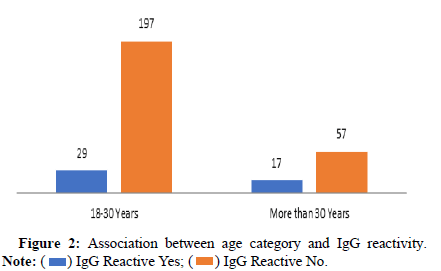
Figure 2: Association between age category and IgG reactivity. Note: ( ) IgG Reactive Yes; (
) IgG Reactive Yes; ( ) IgG Reactive No.
) IgG Reactive No.
Out of 226 subjects under the age group of 18-30 years, 7 (3.1%) were observed to have reactive IgM. Out of 71 subjects under the age group of more than 30 years, 6 (8.5%) were observed to have reactive IgM. No significant differences were observed in the occurrence of anti-SARS CoV-2 IgM antibody according to age (Table 4) (Figure 3).
IgM Reactive
TotalP ValueYesNoAge18-30 YearsCount72192260.054Percentage3.10%96.90%100.00% More than 30 YearsCount66874 Percentage8.50%91.50%100.00% TotalCount13284300 Percentage4.40%95.60%100.00%Table 4: Association between age category and IgM reactivity.
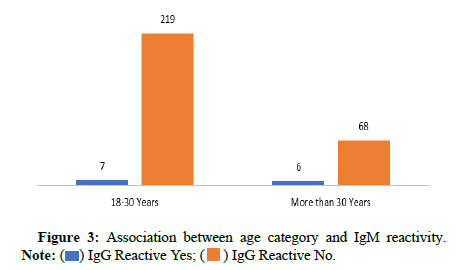
Figure 3: Association between age category and IgM reactivity. Note: ( ) IgG Reactive Yes; (
) IgG Reactive Yes; ( ) IgG Reactive No.
) IgG Reactive No.
Out of 226 subjects under the age group of 18-30 years, 6 (2.7%) were observed to have reactive IgM and IgG. Out of 71 subjects under the age group of more than 30 years, 5 (7.0%) were observed to have reactive IgM and IgG. No significant differences were observed in the occurrence of anti-SARS CoV-2 IgG and IgM antibody according to age (Figure 4).
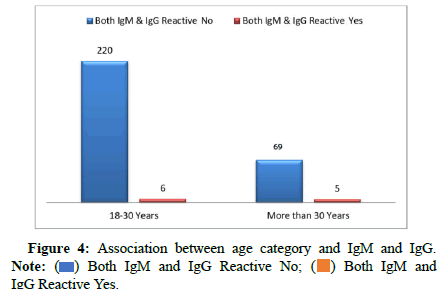
Figure 4: Association between age category and IgM and IgG. Note: ( ) Both IgM and IgG Reactive No; (
) Both IgM and IgG Reactive No; ( ) Both IgM and IgG Reactive Yes.
) Both IgM and IgG Reactive Yes.
Out of 4 subjects with BMI of Less than 18.5 score, 1 (25%) were observed to have reactive IgG and IgM. Out of 65 subjects with BMI of 18.5-24.9, 1 (1.5%) were observed to have reactive IgG and IgM. Out of 50 subjects with BMI of 25-29.9, 3 (6%) were observed to have reactive IgG and IgM. Out of 181 subjects with BMI of More than or equal to 30, 6 (3.3%) were observed to have reactive IgG and IgM. No significant differences were observed in the occurence of anti-SARS CoV-2 IgG and IgM antibody according to BMI (Figure 5).
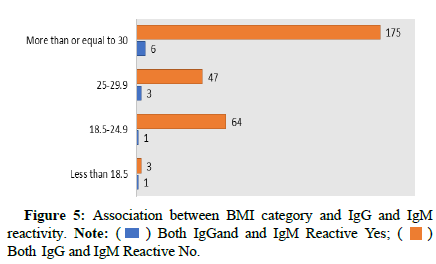
Figure 5: Association between BMI category and IgG and IgM reactivity. Note: ( ) Both IgGand and IgM Reactive Yes; (
) Both IgGand and IgM Reactive Yes; ( ) Both IgG and IgM Reactive No.
) Both IgG and IgM Reactive No.
Out of 4 subjects with blood group of A Negative, none were observed to have reactive IgM and IgG. Out of 91 subjects with blood group of A Positive, 2 (2.2%) were observed to have reactive IgM and IgG. Out of 20 subjects with blood group of AB Positive, 2 (10%) were observed to have reactive IgM and IgG. Out of 4 subjects with blood group of B Negative, none were observed to have reactive IgM and IgG. Out of 68 subjects with blood group of B Positive, 5 (7.4%) were observed to have reactive IgM and IgG. Out of 5 subjects with blood group of O Negative, none were observed to have reactive IgM and IgG. Out of 108 subjects with blood group of O Positive, 2 (1.9%) were observed to have reactive IgM and IgG (Figure 6).
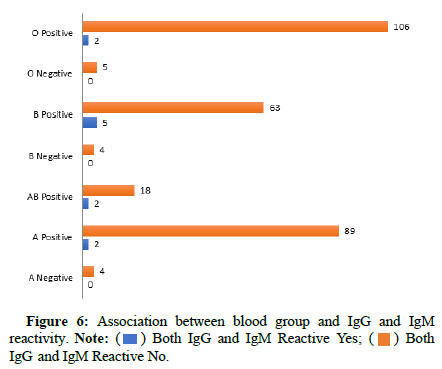
Figure 6: Association between blood group and IgG and IgM reactivity. Note: ( ) Both IgG and IgM Reactive Yes; (
) Both IgG and IgM Reactive Yes; ( ) Both IgG and IgM Reactive No.
) Both IgG and IgM Reactive No.
No statistical significance was observed in the occurence of anti- SARS CoV-2 IgG and IgM antibodies according to various blood groups.
Out of 155 subjects having the history of ayurveda/homeo immune medicine treatment, 7 (4.5%) were observed to have reactive IgG and IgM. Out of 145 subjects having no history of Ayurveda/homeo immune medicine treatment, 4 (2.8%) were observed to have reactive IgG and IgM.
No statistical significance was observed in the occurence of anti- SARS CoV-2 IgG and IgM antibody with history of ayuveda/homeo immune medicine intake (Figure 7).
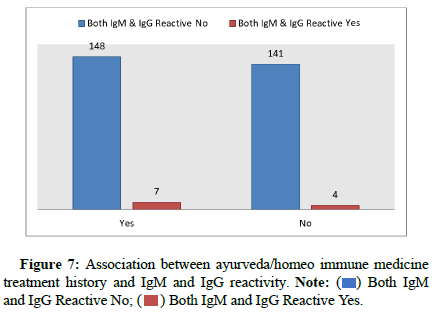
Figure 7: Association between ayurveda/homeo immune medicine treatment history and IgM and IgG reactivity. Note: ( ) Both IgM and IgG Reactive No; (
) Both IgM and IgG Reactive No; ( ) Both IgM and IgG Reactive Yes.
) Both IgM and IgG Reactive Yes.
Discussion
Severe Acute Respiratory Syndrome Coronavirus 2 (SARS-CoV 2) is a novel coronavirus which caused Coronavirus Disease-19 (COVID 19) infection at a pandemic scale. It was first detected in Wuhan city, China, in December 2019 and has since rapidly spread worldwide [3]. COVID-19 leads to a respiratory illness that could range from severe pneumonia to mild respiratory illness. Symptoms including fever, dry cough, fatigue, headache, shortness of breath, and diarrhea are seen in these patients. However, some cases are fully asymptomatic [4]. Asymptomatic or mildly symptomatic persons often are not tested or reported to public health authorities [5]. In addition, because of economic, political, and social difficulties, molecular tests for detecting SARS-CoV-2 often are limited, particularly in developing countries. In this context, alternative measures must be explored to generate reliable data that enable government decisions to contain viral spread [6,7].
The true burden of infection could be measured more accurately with the prevalence of the SARS-CoV-2 antibody [8]. Over the past 25 years, evidence has shown that blood donors are a special class for studying subclinical states describing the prevalence and natural course of infectious diseases [9]. Some studies indicate that the high rate of false-negative tests is because some factors could affect the results, such as biological sample type, insufficient collection, viral load fluctuations, and the period between blood sampling and the symptom onset [10].
The detection of the IgM and IgG antibodies against Severe Acute Respiratory Syndrome Coronavirus 2 (SARS-CoV-2) may play an important role in epidemiological studies. Screening of blood donors for antibodies serves as an indicator of the prevalence of infection in communities [11,12]. While immune responses to SARS-CoV-2 could start as soon as the first week following the symptom onset, in most infected people, seroconversion changes usually start within 10-12 days for IgM and 12-15 days for IgG. Serum IgM levels peak in two to three weeks, whereas IgG antibodies peak in three to four weeks following the symptom onset [13]. Blood donor-based zero surveillance is a powerful and cost-effective strategy bringing about valuable insights into the prevalence and infection of emerging and past infectious threats, such as West Nile virus, Dengue, Chikungunya, and Zika [14-16].
Demographic variables
Sex: A review by Ringwald et al., on keys to get donors to continue giving blood showed that there were fewer women than men among regular donors, especially young women under 45, although figures were similar for both sexes aged 45 and older. The main reason cited was pregnancy and the fact that only 42% of women returned to giving blood after childbirth [17]. In the current study most of the subjects were males (99%) which is in line with the gender related trends in blood donation of India [18].
Age: Most of the subjects in the study were from the age group of 18-30 years. This observation is in line with the previous studies conducted in India and the rest of the world. It is observed that more often young individuals tend to donate blood voluntarily [19,20].
Transfusion related variables
A move towards a totally voluntary blood donor service for all blood products has long been advocated at the international level. As already indicated, under the directive of the Supreme Court buying blood from blood sellers has been officially banned in India from January 1, 1998. The National Blood Policy 2002 is also targeted at achieving 100% voluntary non-remunerated blood donation [21]. Majority of the subjects were voluntary donors (78.3%) in the study. This is similar to an observation made by Rohit Jain et al., in their study [22]. Around 21.7% subjects were replacement donors in our study. In Indian conditions, replacement donors are often the ‘Family Donors’.
The highest prevalent blood group in the study was O positive (36%) which is in line with the other prevalence studies conducted in India. The second most prevalent blood group was A Positive (30.3%) which in contrast to other studies where B positive was observed to be the second most common blood group. However the small disparity between the prevalence of blood group is observed in different regions of India [23-26].
Outcome variables
IgG levels were reactive for 15.3% of the subjects while the IgM levels were reactive only for 4.3% of the subjects. Both IgG and IgM levels were found to be reactive for 3.3% of the subjects.
Host humoral immune response to SARS-CoV-2 among COVID-19-confirmed patients had been characterized by several studies [27-29]. Total Antibody (TAb) specific to SARS-CoV-2, which had been demonstrated to be the most sensitive and earliest serologic biomarker, usually increased since the second week of symptom onset, and second week after onset, all infected cases showed reactive results. In contrast, the IgM and IgG seroconversion generally occurred on the second or third week, following a quick decrease of IgM and a longtime IgG persistence [30]. Studies on serologic screening of specific asymptomatic people showed that seroprevalence of SARS-CoV-2 varied from 1.6% to 10% among different countries and populations [31].
Previous studies showed that, among the blood groups, the highest seroprevalence of COVID-19 was in blood groups O, A, B, and AB, respectively [31-33]. The current study showed that the highest seroprevalence is in blood group AB Positive (10%) followed by B Positive (7.4%) A positive (2.2%) and O Positive (1.9%) however, highest seroprevalence considering IgG was observed in blood group B Positive (23.5%), O Positive (13.9%), AB Positive (15.0%) and A Positive (13.2%). The contrast can be attributed to fact that the current study found no association between the blood groups and the seropositivity.
There was no association observed between the seropositivity and other factors such as BMI or Ayurveda/homeo immune medicine treatment history. Interestingly, IgG was more reactive in subjects with age more than 30 years. This is in line with a previous study conducted in Saudi Arabia [34].
Strength and Limitation
This is one of the early studies conducted in Kerala, examining Seroprevalence of SARS-CoV-2(COVID-19) antibody among blood donors in a tertiary care center.
Most of the study participants were males. Even though the prevalence of females among blood donors is less, we consider this as a limitation while generalizing the study findings in female population. Similarly, subgroup sizes of Rh negative blood groups were small. Hence there is a possible limitation in the generalization of results for these blood groups.
Further Recommendations
This study provides insight into the Seroprevalence of SARSCoV- 2(COVID-19) antibody among blood donors in a tertiary care center.
• Future research should focus on Seroprevalence of SARSCoV- 2(COVID-19) antibody among female blood donors.
• Future research should focus on Seroprevalence of SARSCoV- 2(COVID-19) antibody among Rh Negative blood donors.
Conclusion
The prevalence of SARS CoV-2 antibodies among asymptomatic blood donors was high. The overall seropositivity in the current study was found to be 15.3% for IgG and 4.3% for IgM which is comparable to seroprevalence studies conducted in the United States and Wuhan in China. No significant difference was observed across age groups, diet, BMI, ABO/Rh blood type or Ayurveda/homeo immune medicine intake in respect to IgG and IgM reactivity.
Neutralizing antibody assays will help to understand the immune responses to SARS-CoV-2 among healthy asymptomatic regular blood donors over a period of time. Identifying the seropositive blood units will help to monitor any benefits or serious adverse events to the recipients arising due to transfusion of such blood or blood components.
Real time seroprevalence studies will help to know the herd immunity among the blood donors which will assist in knowing the COVID-19 transmission dynamics, distribution of immunity levels at a particular point of time, immunity gaps, and development of novel therapeutics and prioritize the vaccination programmes to high risk individuals.
References
- Eckerle I, Meyer B (2020) SARS-CoV-2 seroprevalence in COVID-19 hotspots. The Lancet 396(10250):514-515.
- Younas A, Waheed S, Khawaja S, Imam M, Borhany M, et al., (2020) Seroprevalence of SARS-CoV-2 antibodies among healthy blood donors in Karachi, Pakistan. Transfus Apher Sci 59(6):102923.
- Li H, Liu SM, Yu XH, Tang SL, Tang CK (2020) Coronavirus disease 2019 (COVID-19):Current status and future perspectives. Int J Antimicrob Agents 55(5):105951.
- Sadeghi Dousari A, Taati Moghadam M, Satarzadeh N (2020) COVID-19 (Coronavirus disease 2019): A new coronavirus disease. Infect Drug Resist 12:2819-2828.
- Buitrago-Garcia D, Egli-Gany D, Counotte MJ, Hossmann S, Imeri H, et al., (2020) Occurrence and transmission potential of asymptomatic and presymptomatic SARS-CoV-2 infections: A living systematic review and meta-analysis. PLoS medicine 17(9):e1003346.
- Zhou W, Xu X, Chang Z, Wang H, Zhong X, et al., (2021) The dynamic changes of serum IgM and IgG against SARSâ?CoVâ?2 in patients with COVIDâ?19. J Med Virol 93(2):924-933.
- Sun B, Feng Y, Mo X, Zheng P, Wang Q, et al., (2020) Kinetics of SARS-CoV-2 specific IgM and IgG responses in COVID-19 patients. Emerg Microbes Infect 9(1):940-948.
- Lai CC, Wang JH, Hsueh PR (2020) Population-based seroprevalence surveys of anti-SARS-CoV-2 antibody: An up-to-date review. Int J Infect Dis 101:314-322.
- Chen X, Chen Z, Azman AS, Deng X, Sun R, et al., (2021) Serological evidence of human infection with SARS-CoV-2: A systematic review and meta-analysis. Lancet Glob Health 9(5):e598-609.
- Prati DA, Capelli CA, Zanella AL, Mozzi FU, Bosoni PA, et al., (1996) Influence of different hepatitis C virus genotypes on the course of asymptomatic hepatitis C virus infection. Gastroenterology 110(1):178-183.
- Yong SE, Anderson DE, Wei WE, Pang J, Chia WN, et al., (2020) Connecting clusters of COVID-19: an epidemiological and serological investigation. Lancet Infect Dis 20(7):809-815.
- Sughayer MA, Mansour A, Al Nuirat A, Souan L, Ghanem M, et al., (2020) Covid-19 seroprevalence rate in healthy blood donors from a community under strict lockdown measures.
- Guo L, Ren L, Yang S, Xiao M, Chang D, et al., (2020) Profiling early humoral response to diagnose novel coronavirus disease (COVID-19). Clin Infect Dis 71(15):778-785.
- Williamson PC, Linnen JM, Kessler DA, Shaz BH, Kamel H, et al., (2017) First cases of Zika virus–infected US blood donors outside states with areas of active transmission. Transfusion 57:770-778.
- Stone M, Bakkour S, Lanteri MC, Brambilla D, Simmons G, et al., (2020) Zika virus RNA and IgM persistence in blood compartments and body fluids: A prospective observational study. Lancet Infect Dis 20(12):1446-1456.
- Saá P, Proctor M, Foster G, Krysztof D, Winton C, et al., (2018) Investigational testing for Zika virus among US blood donors. N Engl J Med 378(19):1778-1788.
- Madrona DP, Herrera MD, Jiménez DP, Giraldo SG, Campos RR (2014) Women as whole blood donors: offers, donations and deferrals in the province of Huelva, south-western Spain. Blood Transfus 12(Suppl 1):s11.
- Unnikrishnan B, Rao P, Kumar N, Ganti S, Prasad R, et al., (2011) Profile of blood donors and reasons for deferral in coastal South India. Australas Med J 4(7):379.
- Shaz BH, James AB, Hillyer KL, Schreiber GB, Hillyer CD (2011) Demographic patterns of blood donors and donations in a large metropolitan area. J Natl Med Assoc 103(4):351-357.
- Lattimore S, Wickenden C, Brailsford SR (2015) Blood donors in England and North Wales: demography and patterns of donation. Transfus 55(1):91-99.
- Fernandes H, D’souza PF, D’souza PM (2010) Prevalence of transfusion transmitted infections in voluntary and replacement donors. Indian J Hematol Blood Transfus 26:89-91.
- Jain R, Gupta G (2012) Family/friend donors are not true voluntary donors. Asian J Transfus Sci 6(1):29.
- Agrawal A, Tiwari AK, Mehta N, Bhattacharya P, Wankhede R, et al., (2014) ABO and Rh (D) group distribution and gene frequency; the first multicentric study in India. Asian J Transfus Sci 8(2):121.
- Chandra T, Gupta A (2012) Prevalence of ABO and rhesus blood groups in northern India. J Blood Disord Transfus 3(5):132.
- Das PK, Nair SC, Harris VK, Rose D, Mammen JJ, et al., (2001) Distribution of ABO and Rh-D blood groups among blood donors in a tertiary care centre in South India. Trop Doct 31(1):47-8.
- Chang L, Hou W, Zhao L, Zhang Y, Wang Y, et al., (2021) The prevalence of antibodies to SARS-CoV-2 among blood donors in China. Nat Commun 12(1):1383.
- Zhao J, Yuan Q, Wang H, Liu W, Liao X, et al., (2020) Antibody responses to SARS-CoV-2 in patients with novel coronavirus disease 2019. Clin Infect Dis 71(16):2027-2034.
- Sethuraman N, Jeremiah SS, Ryo A (2020) Interpreting diagnostic tests for SARS-CoV-2. Jama 323(22):2249-2251.
- Long QX, Liu BZ, Deng HJ, Wu GC, Deng K, et al., (2020) Antibody responses to SARS-CoV-2 in patients with COVID-19. Nat Med 26(6):845-848.
- Liu A, Li Y, Huang Y, Xu D (2021) Antibody responses against SARSâ?CoVâ?2 in COVIDâ?19 patients. J Med Virol 93(1):144.
- Nourmohammadi H, Dehkordi AH, Adibi A, Amin Hashemipour SM, Abdan M, et al., (2022) Seroprevalence of COVID-19 in Blood Donors: A Systematic Review and Meta-Analysis. Adv Virol.
- Elnasser Z, Obeidat H, Amarin Z, Alrabadi N, Jaradat A, et al., (2021) Prevalence of COVID-19 among blood donors: The Jordan University of Science and Technology experience. Med 100(41).
- Chaves DG, Takahashi RH, Campelo F, da Silva Malta MC, de Oliveira IR, et al., (2022) SARS-CoV-2 IgG seroprevalence among blood donors as a monitor of the COVID-19 epidemic, Brazil. Emerg Infect Dis 28(4):734.
- Banjar A, Al-Tawfiq JA, Alruwaily A, Alserehi H, Al-Qunaibet A, et al., (2021) Seroprevalence of antibodies to SARS-CoV-2 among blood donors in the early months of the pandemic in Saudi Arabia. Int J Infect Dis 104:452-457.
 Spanish
Spanish  Chinese
Chinese  Russian
Russian  German
German  French
French  Japanese
Japanese  Portuguese
Portuguese  Hindi
Hindi 
